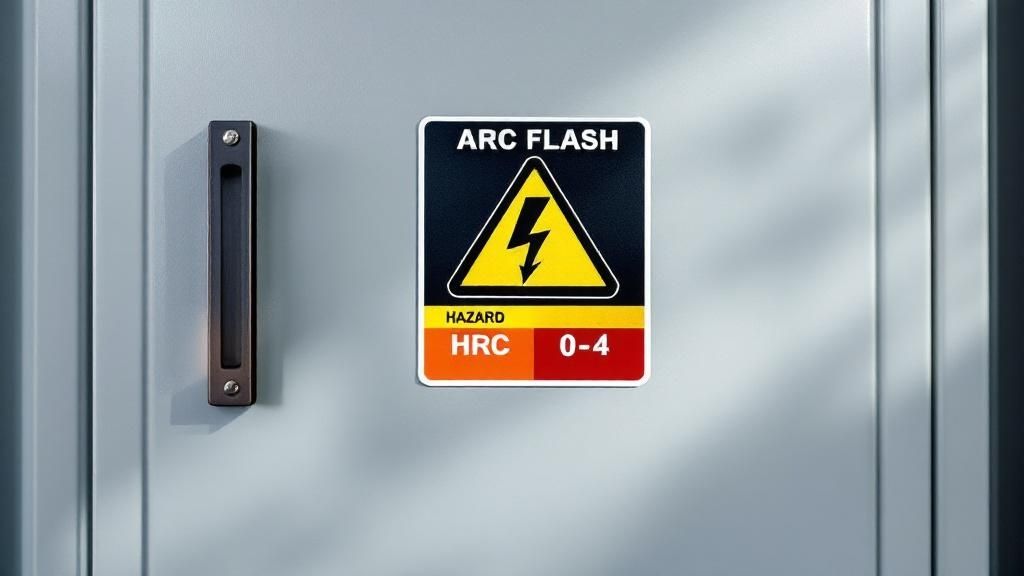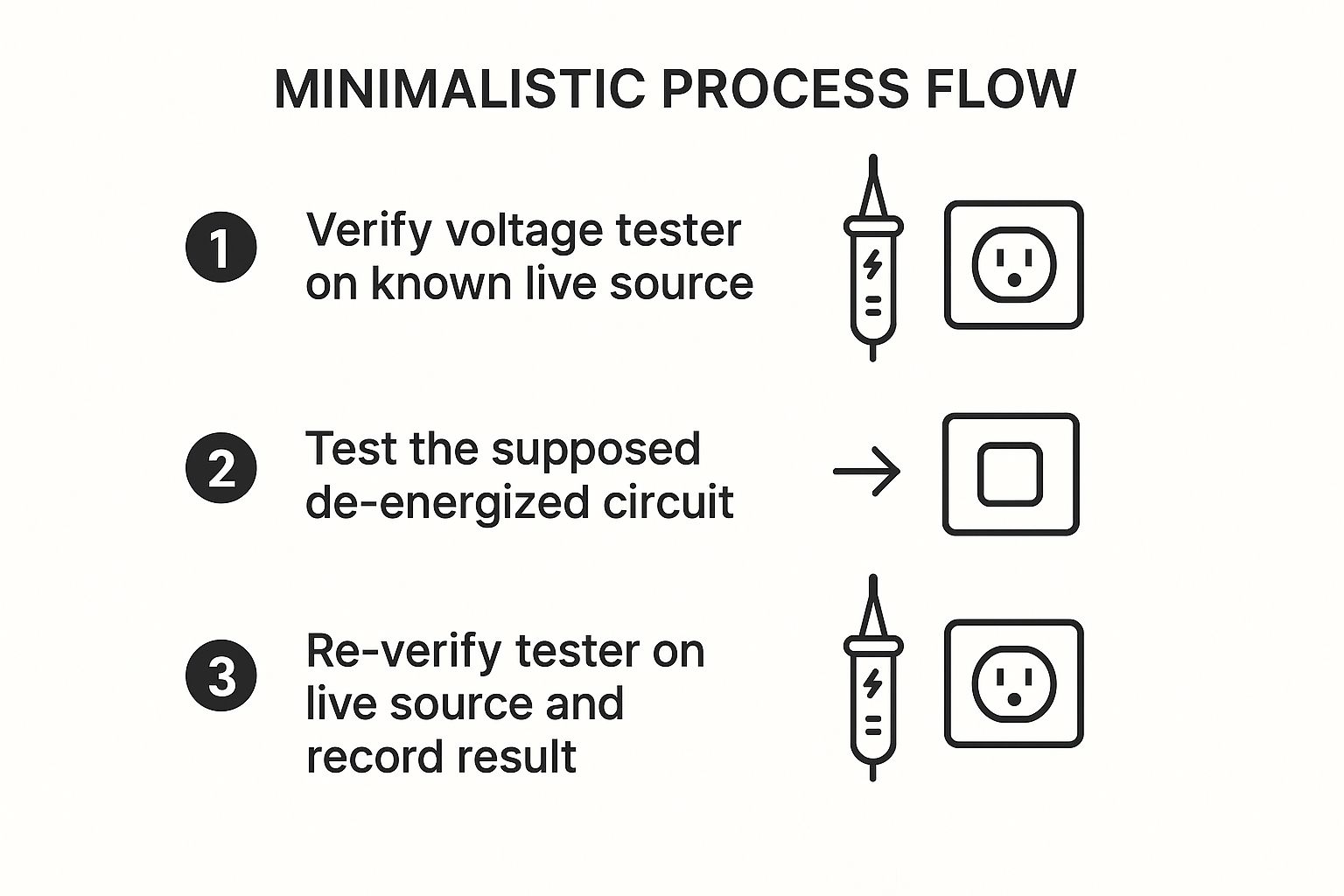Electrical work, whether in the field or within facility walls, carries inherent risks that demand more than just common sense. It requires a systematic, proactive approach to safety. As technology and regulations evolve, so too must our safety protocols. A simple list of 'do's and 'don'ts' is no longer sufficient for protecting technicians and support staff alike. Today’s environment calls for a robust, documented electrical safety checklist that integrates procedural rigor with modern best practices.
This guide presents eight critical components of a comprehensive safety plan, designed to protect both seasoned electricians and the administrative teams who support them. We will move beyond generic advice to provide actionable steps, real-world examples, and specific standards for each checklist item, ensuring your team is not just compliant, but genuinely safe. From implementing meticulous Lockout/Tagout procedures to leveraging technology for better documentation, this is your blueprint for building a culture of electrical safety that sticks.
We will focus on the specific safety checks and procedures that field crews and office personnel must manage. For further information on broader electrical topics and general systems, exploring external resources can provide additional insights. This article, however, hones in on the practical, repeatable actions that prevent accidents.
1. Lockout/Tagout (LOTO) Procedures
Lockout/Tagout (LOTO) is a critical safety protocol designed to protect workers from the unexpected startup or release of stored energy from machines and electrical circuits. The procedure involves physically isolating an energy source with a dedicated lock and attaching a tag to warn others not to operate the equipment. This two-part system is a cornerstone of any comprehensive electrical safety checklist, preventing potentially fatal accidents during maintenance and service work.

This method ensures a piece of equipment is completely de-energized and cannot be turned back on until the authorized employee removes their personal lock. It's a non-negotiable step when performing tasks on any equipment that could move, cycle, or release hazardous energy.
When to Implement LOTO
LOTO procedures are mandatory whenever an employee needs to remove or bypass a safety guard, or when they must place any part of their body into a "danger zone" where equipment operates.
- Manufacturing: A technician servicing a conveyor belt applies LOTO to the main electrical disconnect, preventing anyone from starting the belt while they work on it.
- Construction: An electrician working on the high-voltage systems of a tower crane will lock out the main power source, ensuring the crane cannot be energized.
- Data Centers: Before replacing a power distribution unit (PDU), an engineer locks out the upstream circuit breaker to prevent electrocution.
Actionable Tips for Effective LOTO
To ensure your LOTO program is robust and effective, follow these best practices:
- Test for Zero Energy: After applying a lockout device, always use a voltmeter or other appropriate testing equipment to verify that the circuit is truly de-energized. Never assume a circuit is dead.
- One Person, One Lock: Every technician must have their own unique, standardized lock and key. No one else should have a key to an employee's personal lock.
- Keep Detailed Records: Maintain a log of all LOTO activities. Document the date, time, equipment involved, and the names of the employees who applied and removed the locks.
- Conduct Regular Training: All affected and authorized employees must receive initial training and periodic refresher courses to ensure they understand and follow the LOTO procedures correctly.
2. Personal Protective Equipment (PPE) Verification
Personal Protective Equipment (PPE) is the last line of defense against electrical hazards like arc flash and shock. PPE verification involves the systematic inspection and correct use of specialized gear, including arc-rated clothing, insulated gloves, face shields, and hard hats. This process ensures that the equipment designed to protect workers is in proper condition and meets the required safety standards for the task at hand, making it a non-negotiable part of any electrical safety checklist.

Simply having PPE is not enough; it must be appropriate for the specific voltage and potential arc flash energy. Verifying its integrity before every use prevents equipment failure at a critical moment, which can mean the difference between a close call and a catastrophic injury.
When to Verify PPE
PPE verification is mandatory before any employee works on or near energized electrical conductors or circuit parts. The level of PPE required is determined by a thorough risk assessment.
- Utility Work: A lineworker will verify their Class 2 insulated gloves and arc-rated clothing before working on a 480V panel, ensuring protection from shock and arc flash.
- Industrial Maintenance: An electrician servicing a variable frequency drive (VFD) inspects their arc-rated face shield and balaclava for any damage before starting work.
- Hospital Facilities: A maintenance technician verifies their PPE's arc rating (CAT rating) matches the requirements listed on the electrical panel's warning label before performing diagnostics.
Actionable Tips for Effective PPE Verification
A consistent inspection routine is crucial for maintaining the safety of your team. Implement these practices to ensure your PPE program is effective:
- Perform Daily Visual Inspections: Before each use, carefully inspect all PPE for cuts, tears, punctures, or signs of chemical or heat damage. For insulated gloves, perform an air inflation test to check for pinholes.
- Follow Manufacturer's Instructions: Adhere strictly to the manufacturer's guidelines for cleaning, storing, and maintaining PPE. Improper care can degrade its protective qualities.
- Replace Damaged PPE Immediately: If any defect is found, no matter how small, the equipment must be removed from service immediately. Never use damaged or expired PPE.
- Ensure Proper Fit: Ill-fitting PPE can be a hazard itself and may discourage use. Ensure all equipment fits correctly and comfortably to promote consistent compliance.
3. Ground Fault Circuit Interrupter (GFCI) Testing
A Ground Fault Circuit Interrupter (GFCI) is a life-saving device engineered to protect people from severe electrical shocks. It constantly monitors the flow of electricity in a circuit and, if it detects a ground fault or even a minuscule current leakage, it shuts off the power in milliseconds. This rapid response makes GFCIs a fundamental component of any modern electrical safety checklist, especially in areas where electricity and water may come into contact.
Unlike a standard circuit breaker that protects against overloads, a GFCI protects people. It works by comparing the amount of current going into an appliance with the amount returning. If there's a discrepancy, it assumes the current is leaking to the ground through an unintended path (like a person) and immediately cuts the circuit.
When to Implement GFCI Testing
Regular GFCI testing is crucial in any environment where they are installed, particularly in damp or wet locations as mandated by electrical codes.
- Construction Sites: All temporary power must use GFCI protection. A site manager ensures all portable GFCIs for power tools are tested before each day's use to protect workers from ground faults.
- Restaurants: Kitchens are high-risk areas due to moisture. Staff should be trained to test the GFCI outlets for refrigerators, mixers, and other appliances monthly.
- Swimming Pools: All electrical equipment near pools, including pumps, lighting, and outlets, must have GFCI protection that is tested regularly to prevent electrocution.
- Healthcare Facilities: GFCIs in patient care areas are tested on a strict schedule to ensure the safety of both patients and medical staff using electrical equipment.
Actionable Tips for Effective GFCI Testing
To maintain the reliability of your GFCIs, integrate these practices into your safety routine:
- Test Monthly: Press the "TEST" button on every GFCI outlet or breaker each month. The power should cut off instantly. Press the "RESET" button to restore power.
- Replace if Faulty: If a GFCI fails to trip during a test or cannot be reset, it is no longer providing protection. Replace it immediately.
- Log Everything: Maintain a detailed log of all GFCI tests, including the location, date, result, and the name of the person who performed the test. This helps track device performance and ensures accountability.
- Use Circuit Tracers: When unsure which outlets are protected by a specific GFCI breaker, use a circuit tracer to map your circuits. This ensures no protected outlet is missed during testing.
4. Arc Flash Hazard Analysis and Labeling
An arc flash is a dangerous event where an electric current leaves its intended path and travels through the air, releasing massive amounts of destructive energy. An Arc Flash Hazard Analysis is an engineering study that calculates this potential energy (incident energy) at various points in an electrical system. The results are used to create detailed warning labels, a vital component of any electrical safety checklist, that inform workers of the specific hazards and required Personal Protective Equipment (PPE).

These labels provide critical, at-a-glance information, including the arc flash boundary (the safe approach distance) and the level of incident energy. This allows qualified personnel to select the correct flame-resistant clothing and other PPE before approaching or interacting with energized equipment, drastically reducing the risk of severe injury or death.
When to Conduct an Arc Flash Analysis
An arc flash analysis and proper labeling are required for any electrical equipment that is likely to be serviced or maintained while energized. This includes switchboards, panelboards, motor control centers, and industrial control panels.
- Manufacturing Facilities: All electrical panels and motor control centers above 240V are analyzed and labeled to protect maintenance staff working on production machinery.
- Hospitals: Comprehensive arc flash studies are conducted for critical power systems, like those feeding operating rooms and life support, to ensure worker safety during essential maintenance.
- Data Centers: Due to their high-energy electrical systems, data centers implement extensive labeling programs on all power distribution units (PDUs) and switchgear.
Actionable Tips for Effective Arc Flash Management
To ensure your arc flash program is accurate and protects your team, follow these best practices:
- Update Studies Regularly: An arc flash analysis should be reviewed and updated at least every five years, or whenever a major modification is made to the electrical system.
- Train Workers on Labels: Ensure all qualified electrical workers are trained to read, understand, and act on the information provided on arc flash labels.
- Use Accurate Calculation Methods: Employ recognized standards, such as IEEE 1584, for conducting the analysis to ensure the calculated incident energy levels are accurate and reliable.
- Verify Label Accuracy: During routine electrical inspections, field technicians should verify that the installed equipment matches the information documented in the arc flash study and on the label.
5. Electrical Panel and Equipment Inspection
Regular inspection of electrical panels, switchgear, and related equipment is a fundamental practice for preventing electrical failures and ensuring workplace safety. This process involves a systematic visual and instrumental examination to identify hazards like loose connections, corrosion, overheating, and improper modifications. A thorough inspection is a proactive measure on any electrical safety checklist, helping to catch potential disasters before they happen.
By systematically checking these critical components, organizations can ensure they are in proper working order, compliant with safety codes, and not posing a hidden threat. This preventive maintenance is far less costly and disruptive than dealing with an unexpected power outage or, worse, an electrical fire.
When to Conduct Inspections
Inspections should be performed on a regular schedule and any time there are concerns about electrical system performance. The frequency depends on the environment and equipment age, but regular checks are always necessary.
- Hospitals: Annual inspections of all electrical panels are critical to ensure uninterrupted power for life-support systems and sensitive medical equipment.
- Manufacturing Plants: Technicians use thermography (infrared scanning) during quarterly inspections to detect hot spots on machinery connections, which indicate a potential failure point.
- Commercial Buildings: Property managers schedule routine panel inspections to verify clear working space is maintained and that no circuits are overloaded, especially after a new tenant moves in.
Actionable Tips for Effective Inspections
To get the most value from your electrical inspections and maintain a safe environment, follow these professional tips:
- Use Qualified Personnel: Only trained and qualified electrical workers should open panels and perform inspections. They have the expertise to recognize hazards safely.
- Follow Manufacturer Guidelines: Always refer to the manufacturer's recommendations for inspection frequency and specific points to check for each piece of equipment.
- Document Everything: Create detailed inspection reports with photographs, notes, and any measurements taken (e.g., thermal readings). This creates a historical record for tracking and compliance.
- Prioritize Repairs: Classify findings based on their risk level. Address critical safety issues like exposed wires or signs of arcing immediately, while scheduling less urgent repairs.
6. Proper Tool Inspection and Insulation Testing
Proper tool inspection and insulation testing are fundamental practices for preventing electrical shock and ensuring worker safety. This involves the regular examination of hand and power tools for physical damage and periodic electrical testing to confirm their insulating properties are intact. A well-maintained tool is a worker's first line of defense, making this a non-negotiable part of any electrical safety checklist.

This proactive approach ensures that the tools designed to protect technicians from live circuits have not been compromised. Even a small crack in the insulation of a screwdriver or pliers can create a path for electricity, leading to severe injury or fatality.
When to Inspect and Test Tools
Daily visual inspections are essential before each use, while more formal electrical testing should be performed on a regular schedule. This is crucial for any role where insulated tools are used near energized components.
- Utility Companies: Linemen's insulated hand tools (e.g., hot sticks, insulated pliers) are subjected to rigorous electrical testing every six months to a year to ensure they meet safety standards for high-voltage work.
- Industrial Maintenance: An on-site maintenance shop may implement monthly checks and annual dielectric testing for all insulated tools used in the facility.
- Electrical Contractors: Electricians should perform a visual check of their tools every morning, looking for cracks, cuts, or wear on the insulating handles before starting work on any job site.
Actionable Tips for Effective Tool Maintenance
To create a reliable tool inspection program, integrate these best practices into your daily and periodic safety routines:
- Establish a Testing Schedule: Create and follow a formal schedule for dielectric testing based on manufacturer guidelines, OSHA standards, and frequency of use. High-voltage tools require more frequent testing.
- Train for Daily Visuals: Teach all technicians to perform a quick but thorough visual inspection of their tools daily. Look for damaged handles, cracked insulation, and frayed cords.
- Implement a Tag-Out System: Immediately remove any damaged or failed tool from service. Apply a "Do Not Use" tag and store it separately to prevent accidental use.
- Use Proper Storage: Protect tools from damage by storing them in dedicated toolboxes or bags. Avoid throwing them in with sharp objects that could compromise the insulation.
- Maintain Detailed Records: Keep a log of all inspections, tests, and maintenance performed on each insulated tool. This documentation is crucial for compliance and tracking the tool's lifecycle.
7. Voltage Testing and Verification Procedures
Voltage testing and verification is a non-negotiable safety practice that confirms whether an electrical circuit is truly de-energized before any work begins. This systematic process involves using calibrated test instruments to detect the presence or absence of voltage, preventing severe or fatal shocks from circuits assumed to be dead. This step is a fundamental part of any robust electrical safety checklist, serving as the final confirmation that a system is safe to touch.
This procedure, often called "live-dead-live," ensures the testing instrument itself is functioning correctly, eliminating false negatives that could lead to a catastrophic accident. It is the definitive method to verify that Lockout/Tagout procedures were successful.
When to Test and Verify Voltage
Voltage verification is required every time a worker is about to make physical contact with electrical conductors or circuit parts that have been de-energized. It's the "trust but verify" step of electrical work.
- Commercial Electricians: Before installing new wiring in a branch circuit, an electrician tests the conductors to confirm the breaker has de-energized them.
- Industrial Maintenance: A technician verifies a motor's power circuit is dead at the motor terminals before starting mechanical repairs.
- Utility Workers: A lineman tests a distribution line with a high-voltage detector to ensure it is de-energized before performing maintenance.
Actionable Tips for Effective Voltage Verification
To ensure your voltage testing procedures are reliable and keep your team safe, integrate these best practices:
- Test Your Tester: The "live-dead-live" method is critical. Always test your voltage detector on a known live source first, then on the target circuit, and finally on the known live source again to ensure the meter worked throughout the test.
- Use Contact Testers: Whenever possible, use a qualified, contact-type voltmeter for the final verification. Non-contact voltage testers are great for initial checks but should not be the sole device used to prove a zero-energy state.
- Wear Appropriate PPE: Always wear the correct level of arc-rated clothing, insulated gloves, and other required PPE during voltage testing, as you are interacting with a potentially live circuit.
- Document Your Findings: Record all voltage verification results in a safety log or work order. This creates a formal record that safety protocols were followed.
The following infographic illustrates the essential three-step sequence for safe and reliable voltage verification.

This simple but critical process ensures the testing instrument is functioning correctly before and after the test, confirming the accuracy of the "zero voltage" reading.
8. Electrical Work Permit and Planning System
An Electrical Work Permit and Planning System is a formal documentation process that ensures all hazardous electrical work is meticulously planned, reviewed, and authorized before it begins. This system acts as a procedural safeguard, forcing a thorough evaluation of risks, required safety measures, and personnel qualifications. It’s a vital component of a proactive electrical safety checklist, transforming safety from an assumption into a documented, verifiable procedure.
By requiring a written permit, companies create a clear record of due diligence and ensure that every high-risk task is approached with a pre-approved safety plan. This formalizes communication between technicians, supervisors, and other affected staff, preventing missteps and uncoordinated actions that can lead to severe accidents.
When to Implement an Electrical Permit System
A permit-to-work system is essential for any non-routine, high-risk electrical tasks, especially those involving high voltage or work near live components that cannot be de-energized.
- Hospitals: Technicians require a formal permit before performing maintenance on a hospital's critical backup generator system to ensure no disruption to patient care and to manage the high energy risks.
- Data Centers: An engineer must obtain a detailed work permit to modify a primary power distribution unit (PDU), ensuring the plan is reviewed to prevent data loss or catastrophic system failure.
- Chemical Plants: All electrical work, even on low-voltage control circuits in hazardous locations, requires a permit to assess ignition risks and coordinate with plant operations.
Actionable Tips for an Effective Permit System
To ensure your permit system enhances safety rather than just creating paperwork, follow these key practices:
- Require Supervisor Approval: No work should begin until a qualified supervisor has reviewed the plan, assessed the risks, and signed the permit. This provides a crucial second layer of oversight.
- Train Workers on the Process: All electrical workers and supervisors must be thoroughly trained on how to properly complete, understand, and follow the permit procedures.
- Include All Key Safety Information: The permit form must detail the specific task, identified hazards, LOTO points, required PPE, and emergency procedures. Never use a generic, one-size-fits-all form.
- Use Permits for Safety Communication: Treat the permit process as a "toolbox talk" opportunity. The supervisor should review the permit with the entire team at the job site before work starts.
Electrical Safety Checklist: 8-Point Comparison Guide
Integrating Safety into Your Daily Operations
Navigating the complexities of electrical work demands more than just technical skill; it requires an unwavering commitment to safety. The detailed electrical safety checklist we have explored is not merely a list of tasks to be completed. It represents a fundamental shift in operational mindset, moving from reactive problem-solving to proactive hazard prevention. Each point, from the rigorous application of Lockout/Tagout (LOTO) procedures to the meticulous inspection of Personal Protective Equipment (PPE), serves as a critical barrier against potential disaster.
These eight pillars are interconnected. Proper voltage testing is meaningless without first verifying your tools are properly insulated. An Arc Flash Hazard Analysis is only effective if the resulting labels are understood and the required PPE is readily available and inspected. This interconnectedness highlights a crucial truth: electrical safety is a system, not a singular action.
From Checklist to Culture
The true value of an electrical safety checklist is realized when it transitions from a document into a daily habit, fully integrated into every workflow. This transformation requires consistent effort from every team member, from the field technician verifying a circuit is de-energized to the office administrator ensuring work permits are correctly filed. The goal is to build a culture where safety is instinctive, not an afterthought.
Success hinges on a few key principles:
- Active Reinforcement: Regularly review safety procedures during team meetings. Discuss near-misses and successes to provide real-world learning opportunities.
- Empowerment: Give every technician the authority and responsibility to stop work if they identify a potential hazard. This creates a powerful sense of ownership over personal and team safety.
- Accountability and Verification: The most robust safety protocols can falter without a reliable system for documentation and verification. It's not enough to say a check was done; you must be able to prove it.
Making Safety an Operational Asset
Embracing this checklist is not about adding more administrative burden. It’s about safeguarding your most valuable asset: your people. A well-executed safety program directly translates into fewer incidents, reduced downtime, and enhanced operational efficiency. When your team feels secure and supported, they can perform their best work with confidence and precision.
Think of each checklist item as a building block for a safer, more resilient business. By consistently inspecting electrical panels, testing GFCIs, and adhering to formal work permit systems, you are not just complying with regulations. You are actively investing in the longevity of your equipment, the reputation of your company, and the well-being of every employee. Let this guide serve as your foundation for building a workplace where every team member returns home safely at the end of every single day.
Ready to transform your electrical safety checklist from a static document into a dynamic, integrated part of your daily workflow? Discover how Nora, an AI assistant for the trades, can help your team document safety checks, log LOTO procedures, and share vital information instantly from the field. Visit Nora to see how you can streamline compliance and build a stronger safety culture.



